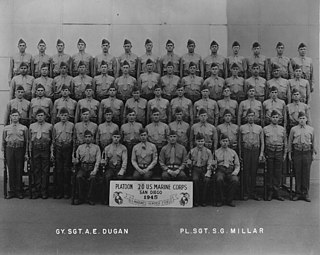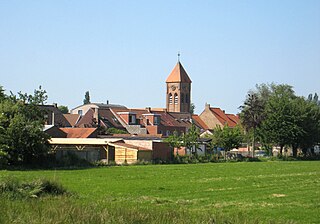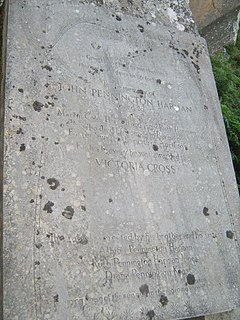
The SA80 is a British family of 5.56×45mm NATO service weapons used by the British Army. The L85 Rifle variant has been the standard issue service rifle of the British Armed Forces since 1987, replacing the L1A1 Self-Loading Rifle. The first prototypes were created in 1976, with production of the A1 variant starting in 1985 and ending in 1994. The A2 variant came to be as the result of a significant upgrade in the early 2000s by Heckler & Koch and remains in service as of 2020. The A3 variant was first issued in 2018 with several new improvements.
A company is a military unit, typically consisting of 80–250 soldiers and usually commanded by a major or a captain. Most companies are formed of three to seven platoons, although the exact number may vary by country, unit type, and structure.

A platoon is a military unit typically composed of two or more squads, sections, or patrols. Platoon organization varies depending on the country and the branch, but a platoon can be composed of 50 people, although specific platoons may range from 10 to 100 people. A platoon is typically the smallest military unit led by a commissioned officer. The platoon leader is usually a junior officer—a second or first lieutenant or an equivalent rank. The officer is usually assisted by a platoon sergeant.
In military terminology, a squad is amongst the smallest of military organizations and is led by a non-commissioned officer. NATO and US doctrine define a squad as an organization "larger than a team, but smaller than a section." while US Army doctrine further defines a squad as a "small military unit typically containing two or more fire teams." In US usage, a squad consists of eight to fourteen soldiers, and may be further subdivided into fireteams.
A fireteam or fire team is a small military sub-subunit of infantry designed to optimise "bounding overwatch" and "fire and movement" tactical doctrine in combat. Depending on mission requirements, a typical fireteam consists of four or fewer members: an automatic rifleman, a grenadier, a rifleman, and a designated team leader. The role of each fireteam leader is to ensure that the fireteam operates as a cohesive unit. Two or three fireteams are organised into a section or squad in co-ordinated operations, which is led by a squad leader. Historically, nations with effective fireteam organisation have had a significantly better performance from their infantry units in combat than those limited to operations by traditionally larger units.
Corporal is a military rank in use in some form by many militaries and by some police forces or other uniformed organizations. Within NATO, each member nation's corresponding military rank of corporal is combined under the NATO-standard rank scale code OR-3 or OR-4. However, there are often differences in how each nation employs corporals. Some militaries do not have corporals, but may instead have a junior sergeant.

The Bren gun was a series of light machine guns (LMG) made by Britain in the 1930s and used in various roles until 1992. While best known for its role as the British and Commonwealth forces' primary infantry LMG in World War II, it was also used in the Korean War and saw service throughout the latter half of the 20th century, including the 1982 Falklands War. Although fitted with a bipod, it could also be mounted on a tripod or be vehicle-mounted.

The Chauchat was the standard light machine gun or "machine rifle" of the French Army during World War I (1914–18). Its official designation was "Fusil Mitrailleur Modele 1915 CSRG". Beginning in June 1916, it was placed into regular service with French infantry, where the troops called it the FM Chauchat, after Colonel Louis Chauchat, the main contributor to its design. The Chauchat in 8mm Lebel was also extensively used in 1917–18 by the American Expeditionary Forces (A.E.F.), where it was officially designated as the "Automatic Rifle, Model 1915 (Chauchat)". A total of 262,000 Chauchats were manufactured between December 1915 and November 1918, including 244,000 chambered for the 8mm Lebel service cartridge, making it the most widely manufactured automatic weapon of World War I. The armies of eight other nations—Belgium, Finland, Greece, Italy, Poland, Romania, Russia, and Serbia—also used the Chauchat machine rifle in fairly large numbers during and after World War I.

The Battle of Moerbrugge was a three-day battle during the Liberation of Belgium.

A light machine gun (LMG) is a light-weight machine gun designed to be operated by a single infantryman, with or without an assistant, as an infantry support weapon. LMGs firing cartridges of the same caliber as the other riflemen of the same combat unit are often referred to as squad automatic weapons.
A section is a military sub-subunit. It usually consists of between six and 20 personnel. NATO and US doctrine define a section as an organization "larger than a squad, but smaller than a platoon." As such, two or more sections usually make up an army platoon or an air force flight.

The Fucile Mitragliatore Breda modello 30 was the standard light machine gun of the Royal Italian Army during World War II.

Lance Corporal John Pennington Harman VC was a British Army soldier and an English recipient of the Victoria Cross (VC), the highest and most prestigious award for gallantry in the face of the enemy that can be awarded to British and Commonwealth forces.
An Assault Pioneer is an infantry soldier who is responsible for:
A weapons company, sometimes called a manoeuvre support company, is a company-sized military unit attached to an infantry battalion to support the rifle companies of the battalion. It usually possesses some combination of machine-guns, mortars, anti-tank missiles, anti-aircraft missiles, reconnaissance vehicles and, sometimes, assault pioneers.

Infantry tactics are the combination of military concepts and methods used by infantry to achieve tactical objectives during combat. The role of the infantry on the battlefield is, typically, to close with and engage the enemy, and hold territorial objectives; infantry tactics are the means by which this is achieved. Infantry commonly makes up the largest proportion of an army's fighting strength, and consequently often suffers the heaviest casualties. Throughout history, infantrymen have sought to minimise their losses in both attack and defence through effective tactics.

The LSAT light machine gun is a component of the Lightweight Small Arms Technologies (LSAT) program. The purpose of the program was to develop a lighter, yet highly reliable light machine gun (LMG). The program was initiated in 2004, when the Joint Service Small Arms Program (JSSAP) challenged the American defence industry to develop a lighter small arms and also design lighter ammunition.

The M249 light machine gun (LMG), also known as the M249 Squad Automatic Weapon (SAW), which continues to be the manufacturer's designation, and formally written as Light Machine Gun, 5.56 mm, M249, is the American adaptation of the Belgian FN Minimi, a light machine gun manufactured by the Belgian company FN Herstal (FN).

1937 Pattern Web Equipment was an item of military load-carrying equipment. It replaced the 1908 Pattern and 1925 Pattern—on which it was based—and was standard issue for British and Commonwealth troops from its introduction in 1937, throughout World War II, and in the post-war period until it was superseded by 58 pattern webbing.